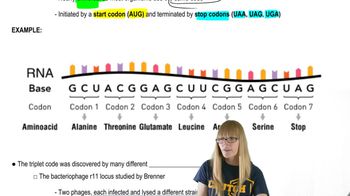Many transcriptional activators are proteins with a DNA-binding domain (DBD) and an activation domain (AD). Explain how each domain contributes to transcriptional initiation. Would you expect repressors to also have each of these domains?
Table of contents
- 1. Introduction to Genetics51m
- 2. Mendel's Laws of Inheritance3h 37m
- 3. Extensions to Mendelian Inheritance2h 41m
- 4. Genetic Mapping and Linkage2h 28m
- 5. Genetics of Bacteria and Viruses1h 21m
- 6. Chromosomal Variation1h 48m
- 7. DNA and Chromosome Structure56m
- 8. DNA Replication1h 10m
- 9. Mitosis and Meiosis1h 34m
- 10. Transcription1h 0m
- 11. Translation58m
- 12. Gene Regulation in Prokaryotes1h 19m
- 13. Gene Regulation in Eukaryotes44m
- 14. Genetic Control of Development44m
- 15. Genomes and Genomics1h 50m
- 16. Transposable Elements47m
- 17. Mutation, Repair, and Recombination1h 6m
- 18. Molecular Genetic Tools19m
- 19. Cancer Genetics29m
- 20. Quantitative Genetics1h 26m
- 21. Population Genetics50m
- 22. Evolutionary Genetics29m
10. Transcription
Transcription in Eukaryotes
Problem 25b
Textbook Question
The accompanying illustration shows a portion of a gene undergoing transcription. The template and coding strands for the gene are labeled, and a segment of DNA sequence is given.

For this gene segment indicate the direction in which RNA polymerase moves as it transcribes this gene.
 Verified step by step guidance
Verified step by step guidance1
Examine the provided illustration to identify the orientation of the template strand and the coding strand. The template strand is the one used by RNA polymerase to synthesize RNA, while the coding strand has the same sequence as the RNA (except thymine is replaced by uracil).
Determine the 5' to 3' directionality of both the template and coding strands. DNA strands are antiparallel, meaning the 5' end of one strand aligns with the 3' end of the other.
Recall that RNA polymerase synthesizes RNA in the 5' to 3' direction. This means it reads the template strand in the 3' to 5' direction.
Using the orientation of the template strand (3' to 5'), deduce the direction in which RNA polymerase moves along the DNA during transcription.
Confirm your conclusion by checking the sequence of the RNA being synthesized. The RNA sequence should complement the template strand and match the coding strand (with uracil replacing thymine).
 Verified video answer for a similar problem:
Verified video answer for a similar problem:This video solution was recommended by our tutors as helpful for the problem above
Video duration:
2mPlay a video:
Was this helpful?
Key Concepts
Here are the essential concepts you must grasp in order to answer the question correctly.
Transcription Process
Transcription is the process by which RNA polymerase synthesizes RNA from a DNA template. During this process, the enzyme reads the DNA sequence and constructs a complementary RNA strand. This occurs in the nucleus of eukaryotic cells and is essential for gene expression, as it converts genetic information from DNA into a form that can be translated into proteins.
Recommended video:
Guided course

mRNA Processing
Directionality of RNA Synthesis
RNA polymerase synthesizes RNA in a 5' to 3' direction, meaning it adds nucleotides to the 3' end of the growing RNA strand. This directionality is crucial because it determines how the RNA strand is built and how it will eventually be translated into proteins. Understanding this directionality helps clarify how the RNA polymerase interacts with the DNA template strand.
Recommended video:
Template and Coding Strands
In transcription, the DNA double helix consists of two strands: the template strand and the coding strand. The template strand is the one that RNA polymerase reads to synthesize RNA, while the coding strand has the same sequence as the RNA (except for uracil replacing thymine). Recognizing which strand serves as the template is essential for determining the direction of RNA polymerase movement during transcription.
Recommended video:
Guided course

The Genetic Code

 9:16m
9:16mWatch next
Master Eukaryotic Transcription with a bite sized video explanation from Kylia
Start learningRelated Videos
Related Practice
Textbook Question
711
views

